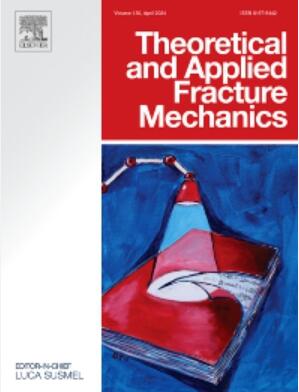Hydrogen embrittlement susceptibility of 301 metastable austenitic stainless steel
IF 5.6
2区 工程技术
Q1 ENGINEERING, MECHANICAL
引用次数: 0
Abstract
The influence of hydrogen on the mechanical properties and embrittlement behavior of 301 metastable austenitic stainless steel was studied. The hydrogen embrittlement (HE) was studied using in situ tensile testing under electrochemical hydrogen charging at various current densities. The results showed that the Portevin-Le-Chatelier (PLC) phenomenon occurred in the uncharged sample, whereas serration disappeared after hydrogen charging due to the hydrogen enhanced decohesion mechanism (HEDE) and the presence of α′ martensite. Hydrogen charging at current density of 10 and 30 mA/cm2 resulted in a 7 and 19 % loss in yield strength and a 77 and 80 % loss of elongation, respectively. The fracture toughness of uncharged and H pre-charged specimens was determined by the indentation technique and the results showed a 35 % decrease in fracture toughness after hydrogen charging. Evaluation of the microstructure by electron backscatter diffraction (EBSD) showed that the dislocation density increased in the presence of hydrogen. In addition, a reduction in stacking fault energy (SFE) by hydrogen resulted in the formation of more α′ martensite in the microstructure, compared to uncharged sample at the same level of deformation.
301亚稳奥氏体不锈钢的氢脆敏感性
研究了氢对301亚稳奥氏体不锈钢力学性能和脆化行为的影响。采用原位拉伸试验研究了不同电流密度下电化学充氢的氢脆(HE)。结果表明,在未带电的样品中出现了Portevin-Le-Chatelier (PLC)现象,而在充氢后,由于氢增强脱粘机制(HEDE)和α′马氏体的存在,锯齿形现象消失。在电流密度为10 mA/cm2和30 mA/cm2时充氢,屈服强度损失7%和19%,伸长率损失77%和80%。用压痕法测定了未充氢和预充氢试样的断裂韧性,结果表明充氢后试样的断裂韧性降低了35%。电子背散射衍射(EBSD)分析表明,在氢的存在下,位错密度增加。此外,在相同变形水平下,与未带电样品相比,氢降低了层错能(SFE),导致微观组织中形成了更多的α′马氏体。
本文章由计算机程序翻译,如有差异,请以英文原文为准。
求助全文
约1分钟内获得全文
求助全文
来源期刊

Theoretical and Applied Fracture Mechanics
工程技术-工程:机械
CiteScore
8.40
自引率
18.90%
发文量
435
审稿时长
37 days
期刊介绍:
Theoretical and Applied Fracture Mechanics'' aims & scopes have been re-designed to cover both the theoretical, applied, and numerical aspects associated with those cracking related phenomena taking place, at a micro-, meso-, and macroscopic level, in materials/components/structures of any kind.
The journal aims to cover the cracking/mechanical behaviour of materials/components/structures in those situations involving both time-independent and time-dependent system of external forces/moments (such as, for instance, quasi-static, impulsive, impact, blasting, creep, contact, and fatigue loading). Since, under the above circumstances, the mechanical behaviour of cracked materials/components/structures is also affected by the environmental conditions, the journal would consider also those theoretical/experimental research works investigating the effect of external variables such as, for instance, the effect of corrosive environments as well as of high/low-temperature.
 求助内容:
求助内容: 应助结果提醒方式:
应助结果提醒方式:


